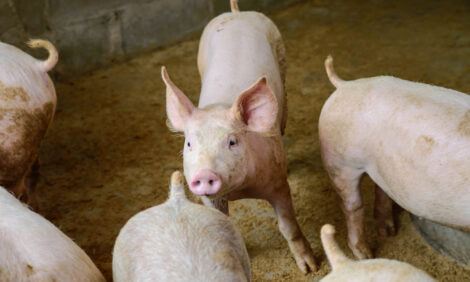



CME: Mixed Signals for US Pork Industry
US - CME's Daily Livestock Report for 25th September 2008.For anyone having trouble finding the archived MCOOL webinar — go to http://www.cmegroup.com/education/browse-materials/ index.html, click on “Commodity Products” and then click on “Country of Origin Labeling Seminar.”
DowJones’ pre-report survey of hog market analysts indicate that they expect tomorrow’s report to show smaller year-on-year increases in market hog supplies and a breeding herd 2.7% smaller than one year ago. The table at left shows the range and average of nine estimates of the key Hogs and Pigs Report variables. The report will be released at 3:00 p.m. EDT and can be easily accessed through the DLR website.
The averages of the estimates appear reasonable. September FI slaughter through 18 weekdays, 3 Saturdays and 1 holiday is 4.15% higher that over the same time period last year. The average estimate for inventories of pigs weighing 180-lbs. and over is +5.2%, slightly high but, should the USDA number come in at that level, probably not high enough to call the report into question.
The June-August Pig Crop number is within 1% of the Under 60- lbs. inventory estimate, so those are reasonable as well. 12,005 head fewer Canadian feeder pigs were imported in July and August 2008 versus the same period in 2007. That number would account for only 0.05% of last September’s Under 60-lb. inventory. Thus, there will be no adjustment needed for comparing the Jun-Aug pig crop to the Under 60-lb. inventory.
Another point of interest is that any year-on-year changes in the inventories in Friday’s report will be comprised almost entirely of U.S. pigs. That is because the growth rate for the number of pigs brought in from Canada has fallen sharply. For the 5 months that ended August 30, only 101,308 more Canadian feeder pigs have been imported versus the same time period in 2007. That is a 3.8% increase over last year but those additional pigs would account for only 0.17% of last year’s September 1 U.S. Market Herd inventory.
The U.S. pork industry has received wildly mixed signals since last fall regarding the need for output reductions. Figure 1 shows ISU’s Estimated Costs and Returns back to 1991. August’s big rally in cutout values and hog prices more than covered high production costs and provided a profit of $8.72/head. September’s average corn, soybean meal and hog prices through yesterday, though, would result in losses of $13.51 per head. Futures prices say more substantial losses are on the way in Q4-’08 and for all but Q2 in 2009.

Figure 2 shows that sow herd reductions tend to get larger in magnitude for three more quarters beyond the first quarter in which a reduction occurs. The magnitude of those subsequent quarters’ reductions was much smaller in the ‘02-’03 liquidation than in the previous two even though losses were nearly as severe. That is probably the result of a much more “fixed asset” modern industry where farms do not shut down quickly.










